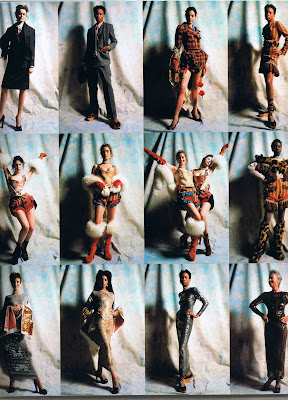Westwood's use of tartan is unparalleled. Her fascination with Scottish traditions - as source of inspiration and subject of parody - reoccurred frequently in her collections and triumphed in Anglomania (A/W 1993). Using a mix of different tartans, her ensembles exploited the rich depth, colour and diversity of the traditional checked pattern. The tartans were made to order by Locharron of Scotland, who also created a special desig for Westwood called the 'McAndreas', after her second husband, Andreas Kronthaler.
_______________________________________________________
About the collections
The title Anglomania referred to the French passion for the all things English -- literature, language, clothing and even food -- that prevailed during the 1780s, when pre-revolutionary, foppish styles were replaced by the plainer English aristocratic look. Westwood's fascination with English and Scottish traditions -- as source of inspiration and subject of parody -- was reiterated in Anglomania with mini-kilt tartan ensembles, special tartan for Westwood called the ' McAndreas' , after her husband.
Her first Anglomania fashion collection was released in Autumn-Winter 1993-1994 and was an embodiment of the desingner's fondness and talent for parodying “the British in the context of a classical perspective”.
Described as “the bewitching empire of the senses for a modern nomad, mixing British eccentricity and Asian intensity to express extrovert femininity”, Anglomania has a very appealing list of notes: green tea, cardamom, coriander, rose, violet, nutmeg, leather, vanilla and amber.
This suit was designed by Vivienne Westwood for her "Anglomania" collection of Autumn/Winter 1993. The jacket and trousers are made from the McAndreas tartan, which was invented by Westwood herself and is named after her husband, Andreas Kronthaler.
The outfit sums up Westwood's interests in history, art, the 18th century, British traditional materials and manufacturing and also refers back to her own earlier collections of the late 1970s.
Man's suit; jacket, bondage trousers and 'baker boy' cap, wool, the pink Gordon tartan, Vivienne Westwood, 'Anglomania' Collection, Autumn-Winter 1993.
This suit from the 'Anglomania' Collection is made from a traditional wool tartan, a textile that fascinates Westwood. She has even designed her own modern tartans for use in her clothes. This example, with its bondage-style trousers, reminds us of Westwood's punk origins.
The suit was worn by Holly Johnson as a solo artist, following the break up of the band 'Frankie Goes to Hollywood' in 1987.
Other Details :
Shoes, pair, womens, 'Super elevated gillies', leather/ cork/ silk, Autumn/ Winter collection, designed by Vivienne Westwood, London, 1993-1994
Naomi Campbell toppled during a Vivienne runway show in these shoes from her 93Anglomania” collection







































